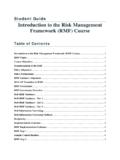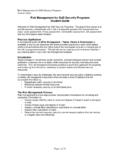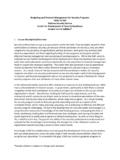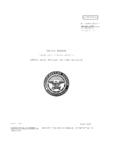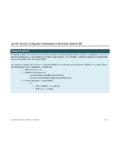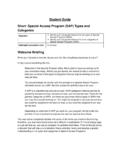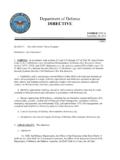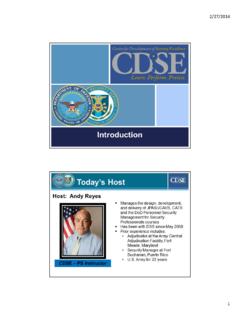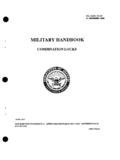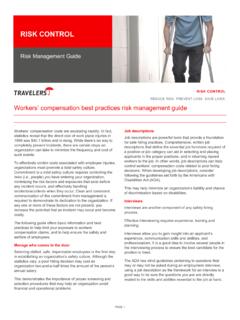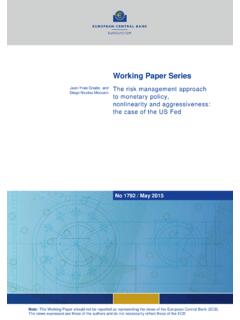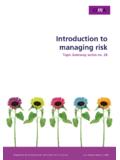Transcription of Risk Management for DoD Security Programs Student Guide
1 Risk Management for DoD Security Programs Student Guide Risk Management for DoD Security Programs Student Guide Welcome to Risk Management for DoD Security Programs . The goal of this course is to provide Security professionals with a risk Management process that incorporates five steps: asset assessment, threat assessment, vulnerability assessment, risk assessment, and countermeasure determination. Practical Application A corresponding job aid (Risk Management Tables, Charts & Worksheets) is available in the course resources link which provides examples of each of the tables, charts and worksheets that are referenced in the courseware and are an integral part of the risk Management process. This job aid can be used as quick reference material or as a starting point in your own risk Management analysis. Introduction Rapid changes in the political, social, economic, and technological arenas have caused protection to become more complex, while resources for Security have become more restricted.
2 The risk Management process provides a systematic approach for acquiring and analyzing the information necessary to protect assets and allocate Security resources. To meet today's Security challenges; the national-level Security policy initiatives endorse a holistic risk Management approach which provides a level of balance that will accomplish the following: Realistically match Security to the threat Effectively allocate limited resources Provide necessary Security at an affordable price The Risk Management Process Risk Management is a five-step process that provides a framework for collecting and evaluating information to: Assess assets (identify value of asset and degree of impact if asset is damaged or lost). Assess threats (type and degree of threat). Assess vulnerabilities (identification and extent of vulnerabilities).
3 Assess risks (calculation of risks ). Determine countermeasures ( Security countermeasure options that can reduce or mitigate risks cost effectively Page 1 of 21. Risk Management for DoD Security Programs Student Guide During the analysis process values are assigned corresponding to the impact of asset loss, threats, and vulnerabilities, and then a resulting risk value is calculated. The final step in the process is to make a risk Management decision. This decision involves analyzing the outcomes from each step (typically using a numerical rating and/or linguistic value) and analyzing the information as a whole to determine the most appropriate countermeasure options for each asset. Impact and Risk Scale Low Medium High Critical Range 0-3 4-13 14-50 51-100. Mid-point 2 8 31 75. Threat and Vulnerability Scale Degree of Low Medium High Critical Threat Range.)
4 Mid-point .12 .37 .62 .87. The Risk Management Process Step 1 Assess Assets The first step in the risk Management process is to identify and assess your organization's assets. An asset is anything of value or importance to the organization or an adversary, such as people, computers, buildings or strategic advantages. This first step determines the value of each asset and prioritizes the asset based upon the consequence of loss. During this step, focus only on assets that are worthy of protection and are most important to your organization and the national Security of the United States. Assets can be assigned to one of five categories: People Information Equipment Facilities Activities & Operations Page 2 of 21. Risk Management for DoD Security Programs Student Guide Each category is broken into multiple levels to assist with capturing details about each asset.
5 Each level within the categories is then used during the asset analysis. Asset analysis studies are done at a Level I, II, III, and IV, or deeper as necessary. (See job aid for an example of the Asset Category Table.). NOTE: Categories can be adjusted to meet your organizational needs. Identify Assets A variety of resources, including reports, databases and equipment documentation, assist in determining significant assets. However, the best information is attained through a series of interviews with knowledgeable personnel or subject matter experts (SMEs), including the following: Customer Program/Facility Manager Chief of Operations Chief of Security When interviewing SMEs, use a structured asset survey questionnaire to determine asset criticality. Questions should include, but not be limited to the following: What critical mission activities take place at this site?
6 Describe. What critical/sensitive information (both classified & unclassified) is located at this site? What critical/valuable equipment is located at this site? Why is it critical/valuable? What assets would be viewed as critical to an adversary? Where are the assets located? Who are the facility personnel, tenants, customers, and visitors? What relationship do they have to the critical mission activities/operations? What do you view as undesirable events to your assets? Describe the expected impact if the event were to occur. Identify Undesirable Events Once you have identified the significant assets, the next step is to identify potential undesirable events. The occurrence of an undesirable event is the focal point of the risk Management process. Document and assign a rating to each potential undesirable event that could adversely affect a specific asset.
7 Research available resources or use the SME interview technique to identify undesirable events. The following questions can help Guide you: What undesirable events have happened in the past? What undesirable events regarding a particular asset concern the asset owner? What undesirable events have happened to similar assets? Measure Impacts Once undesirable events for each asset are identified, the next step is to measure the impact of such an occurrence. Consider the consequences for each asset that is lost, harmed, or otherwise adversely affected. Again research resources and interview SMEs to gain the needed information. Use the following questions as a Guide : Could significant damage to national Security or loss/injury to human life occur as a result of this event? Could ongoing operations be seriously impaired or halted?
8 Page 3 of 21. Risk Management for DoD Security Programs Student Guide Could costly equipment or facilities be damaged or lost? Create Risk Assessment Worksheet Once the impact of an undesirable event is defined, create a Risk Assessment Worksheet for organizing and later analyzing the information to assist with the analysis. At this stage of the risk Management process, populate the first two columns of the worksheet with the following elements: Asset name Undesirable event description and impact or potential loss from the undesirable event Notice that the worksheet contains empty columns. These columns will be completed as you progress through the remaining steps of the risk Management process. (Upon completion of the asset assessment step, the first four columns of the worksheet will be completed.) (See job aid for a Risk Assessment Worksheet).
9 Risk Assessment Worksheet Assign Asset Value Now that you have identified assets and compiled a list of undesirable events, the next step is to assign a linguistic value of the impact: Critical (C) - A critical rating indicates that compromise to the targeted assets would have grave consequences resulting in loss of life, serious injury, or mission failure. High (H) - A high rating indicates that a compromise to assets would have serious consequences resulting in loss of classified or highly sensitive data or equipment/facilities that could impair operations affecting national interest for an indefinite period of time. Medium (M) - A medium rating indicates that a compromise to the assets would have moderate consequences resulting in loss of sensitive information, sensitive Page 4 of 21. Risk Management for DoD Security Programs Student Guide data or costly equipment/property that would impair operations affecting national interests for a limited time period.
10 Low (L) - A low rating indicates that little or no impact on human life or the continuation of operations affecting national Security or national interests would result. Further differentiate each asset by indicating high, medium, and low within each assigned value. For a critical value, designate an asset as a high/critical or a low/critical. Doing so provides the ability to weigh a value between assets. For example, the compromise of Top Secret information may be more detrimental than the loss of Confidential information. Linguistic values, or verbal terms, are less precise than numerical ratings. In addition, it will be more difficult later on in the risk Management process to determine which combinations of ratings equal various risk ratings. Therefore, linguistic values are assigned a numerical rating to determine the degree of an asset within each linguistic category.
